|
|
Post by Solomon on Feb 3, 2021 7:58:29 GMT -8
Is there a diagram of the core available somewhere? Thanks.
|
|
|
|
Post by martyn on Feb 3, 2021 8:42:07 GMT -8
|
|
|
|
Post by peterberg on Feb 3, 2021 12:50:04 GMT -8
Is there a diagram of the core available somewhere? Thanks. For this variant of the batchrocket core, no. No wonder though, the development model is changing almost daily the past week or two. And it's time for an update, at the moment this variant is moving away from the vortex core, coming closer to the original DSR1 now. I've tried a multitude of combinations, the overhang of the shelf being just one aspect. There seems to be an inevitable occurence during startup of a cold core. Around 10 minutes into the burn the CO starts to rise and the inside of the afterburner is coloring brown or pitch black. The CO is rising upto 1500 or 3000 ppm and between 15 and 20 minutes into the burn it comes down sharply. In order to get a certifiable run the CO line should be most of the time below 500 ppm after the peak. A peak that's ragged and goes up and down isn't a good sign, too unstable to my taste. The only way to achieve a low(ish) peak would be a highly insulated afterburner. Trevor mentioned it earlier, there doesn't seem to be a way around it. At this point I was looking what I had lying around for to achieve this goal in another way. Superwool 12 mm, yes, and a (too) short piece of vacuum formed insulating riser tube. This tube was 150 mm diameter, not the 120 mm of the core's system size. But whatever, I decided to try it anyway. The original DSR was equipped with a higher and wider top box although rectangular, so this wouldn't be a huge deviation. So I fiddled with the riser tube, making it lower and creating a port in it. The remainder of the afterburner tube was created by cutting up a 5 liter peanut butter can from the local chinese takeaway and two layers of superwool to form a horizontal 5 minutes afterburner tube, coupled to the vacuum formed piece. It happened to be real fiddling, but in the end I got away with it and it worked. Much better than I thought it would do. This how it looked like before firing up: 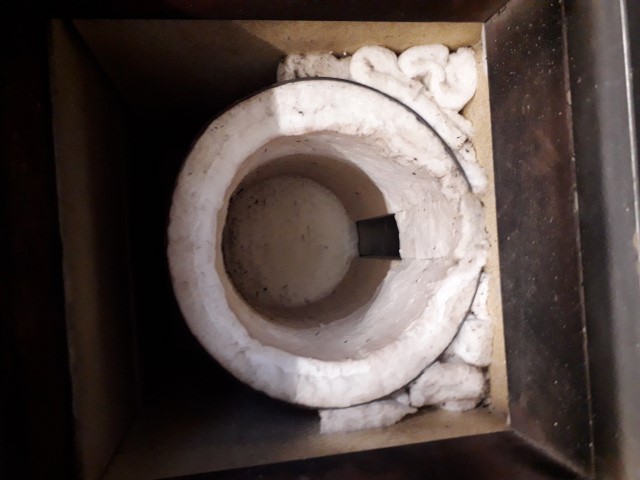 This is the resulting diagram while running the first full test. 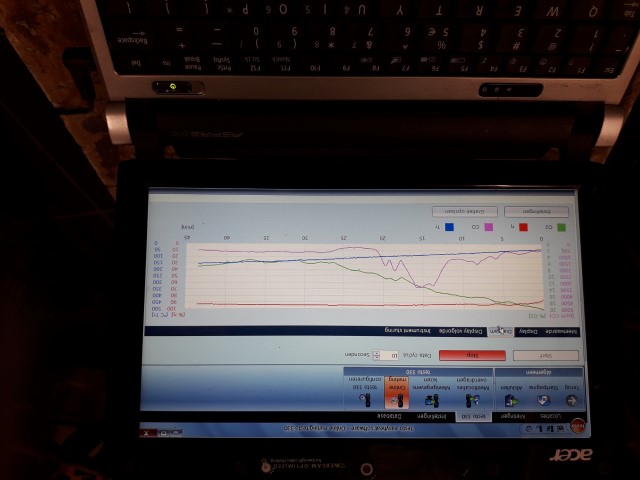 I did a couple of videos while running diverse combinations with the air inlets and end port. The first during the warming up phase: the fountain-like shape is clearly visable, moving from side to side in an irregular fashion. The next one in full burning mode, both sides of the flame curling down but not very regular as well. The third one looks like it's in overfuel mode, but the diagram below it shows it wasn't at all. This is the latest full test, ran yesterday night. Apart from the startup peak it appears to be remarkably stable, in some instances the oxygen level got as low as 4.6 %. A sure recipe for a thermal runaway and lots of black smoke from the chimney, during tests of the straight batchrocket in the past. 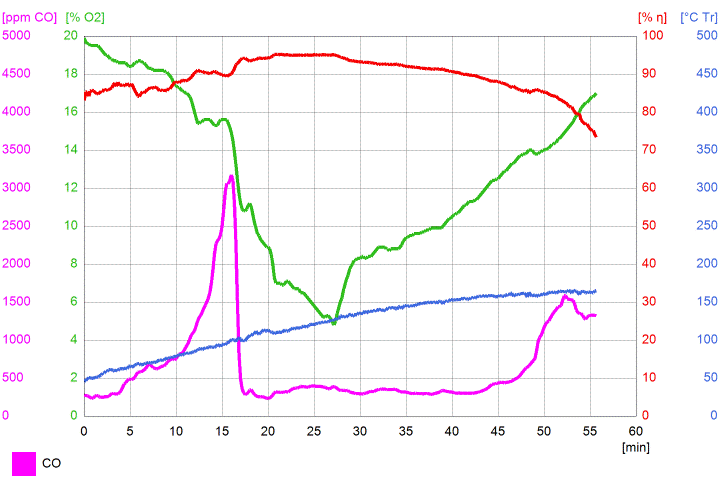 Averages for this run: O² 12.5%, efficiency 89.4%, CO 664 ppm, end temp 121 ºC. That last one is a bit high, more than a month ago I shortened one of the barrels because the end temp stayed too low. The power has been increasing gradually and the barrels are too small now. The end port is full size at the moment, both glass doors are staying reasonably clean and there's no sign of instable behaviour. The above run was done using just softwood, a tad more than half a load in weight. |
|
|
|
Post by Solomon on Feb 3, 2021 13:20:44 GMT -8
Great update.
I guess you need a telescoping barrel.
|
|
sbc84
New Member

Posts: 5
|
Post by sbc84 on Feb 4, 2021 14:06:56 GMT -8
I am not familiar with the dimensions of the dsr1 only the original batch box and the dsr2. Are there any differences in port dimensions?
|
|
|
|
Post by peterberg on Feb 5, 2021 1:08:56 GMT -8
I am not familiar with the dimensions of the dsr1 only the original batch box and the dsr2. Are there any differences in port dimensions? Yes, there are. It's a smaller percentage of the system csa and proportions are different. That said, the port has been about 70% csa uptil now, the DSR1's port is 60% or less. The smaller the port, the higher the gas speedup together with a higher probability for the core to kick into fuel overload and thermal runaway. At this stage it is 55% csa although this could be changed in the near future. |
|
sbc84
New Member

Posts: 5
|
Post by sbc84 on Feb 5, 2021 7:23:02 GMT -8
Thanks again Peter for all your hard work and your sharing of information, results. I have been following rocket heater designs since the early steel lined days and have built multiple test stoves. I am currently working on designing a heater for my 3,200 so ft shop and was planning on utilizing the dsr2 design but I like the direction this design is heading with the much more visible afterburner. Keep up the great work!
|
|
|
|
Post by peterberg on Feb 12, 2021 4:19:11 GMT -8
Thanks for the compliments, sbc84. After some days of letting ideas simmer on the backburner (pun intended) I made some minor changes. The port is a bit narrower and longer than before, approaching 50% of system csa a bit more. There's now an additional primary air provision in the lower rear end of the firebox, a very small duct of just 160 mm² (0.248 "²), one left and one right. Those are both connected to a slow-down box of 30x40x60 mm high(1.18"x1.57"x2.36"), having the opening on the side in order to prevent it from blocking up by ashes. The slow-down boxes are meant to prevent the air blowing at those points, just streaming out gently. And I kept 50 mm (2") of free space above the fuel so it would be possible to shove the kindling and the little barbecue lighter block as far to the rear as I could. The idea was to keep a higher speed in the port, having some fresh air in the back so the high tail-out CO values would be reduced and lighting at the far back to induce the port flames there first. I have been fighting a peak and sometimes a complete mountain range of CO at the start and the tail-out in order to be able to be conform to the upcoming EU norm. A cold start seemed to inevitably be accompanied by a lot of soot, somewhere between 10 and 20 minutes into the burn. Blacking up the top window, causing the CO level to surge. All that fiddling back and forth seems to bear fruit now, yesterday's test run was certainly good enough to pass the certification test. No soot in the dangerous part of the run, jippee! 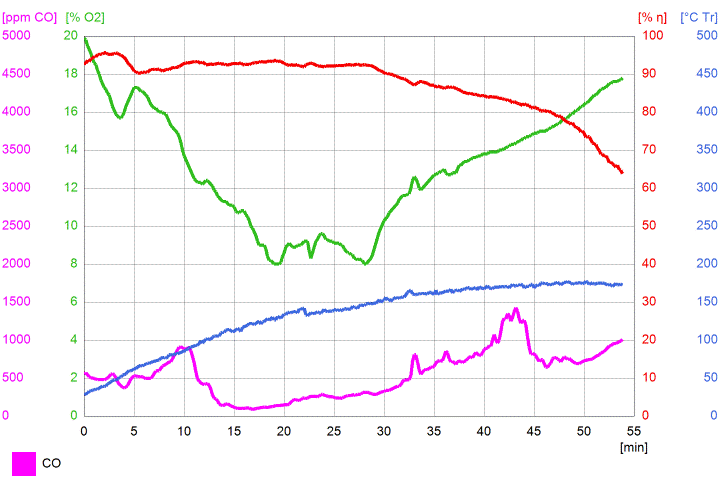 For reference, have a look at the diagram published on Februari 3rd. In the above diagram the peak is reduced to a mole hill and the tail-out is very moderate. These were the main concern points, unlike the straight or sidewinder batchrockets a very low (sometimes down to 4%!) O² level won't kick the thing into fuel overload. Nothing has been done to the air settings during this burn, I let it go just like that, having the door open a crack. It appears it could burn quite commendable with main air inlet blocked off and just a spark screen instead of a door. Averages of this run: O² 13.1%, eff. 87.7%, CO 554 ppm, end temp 132 ºC. Next step: another run using the same fuel (softwood scraps of pallets) and when the results are comparable to this one, another one or two on hardwood species, hornbeam in my case. It's about time better results are coming along, the barrels are starting to deform and the whole setup is showing signs of wear and tear by now. |
|
|
|
Post by peterberg on Feb 13, 2021 12:23:36 GMT -8
Another test run done today. No changes since two days ago, although I checked the afterburner assembly, made it leak free and arranged a better centering of the port. Same fuel and lighting method as before. The result is very encouraging, even better than two days ago. 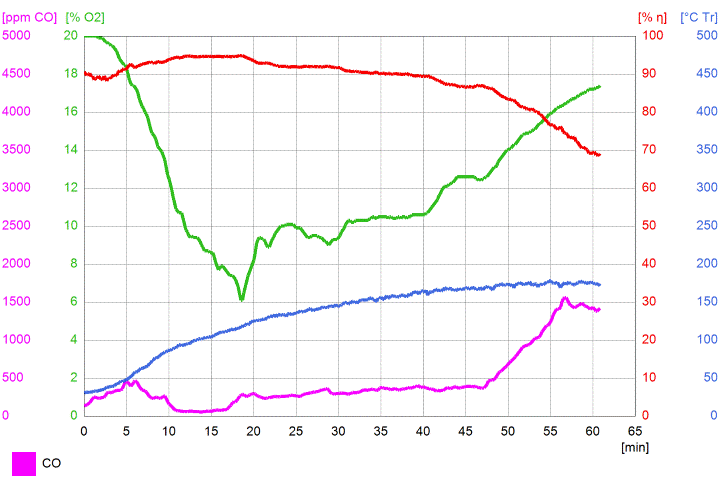 Averages of this one: O² 12.5%, eff. 88.4%, CO 458 ppm, end temp 132.4 ºC. Lowest levels: O² 6.1%, eff. 68.5%, CO 56 ppm, end temp 30 ºC. Right now I am awaiting a 150 mm riser tube from Joris Pouls, a heater builder in Belgium, who's donating one to the development of this core. By using this I am able to get rid of the instable metal shell and the shrinking superwool liner of the extension. Next step: installing the new afterburner tube and testing the thingy with hornbeam fuel. |
|
|
|
Post by peterberg on Feb 13, 2021 13:19:03 GMT -8
A new batchrocket video, number 33 this time, picturing the above mentioned test run.
|
|
|
|
Post by martyn on Feb 14, 2021 2:33:24 GMT -8
Interesting ... so now a much easier build with a powerful performance but not quite such an impressive display or perhaps it is even more impressive but it does not show in the video?
|
|
|
|
Post by peterberg on Feb 14, 2021 10:18:00 GMT -8
Interesting ... so now a much easier build with a powerful performance but not quite such an impressive display or perhaps it is even more impressive but it does not show in the video? I'd think the first goal is to develop a reliable and stable build. Having said that, the visability of the afterburner is one of the main reasons to choose this concept for development again. And the display is different, yes, but in my opinion as mesmerizing as the flat double vortex. The video doesn't do it justice, the separate flames are visable all the time but the camera can "see" it up close only. One of the things that I don't understand as yet is this: the end port size is 100% of system csa and the space over the riser tube is 98% csa. It looks like there isn't any restriction in the downstream trajectory although at the same time the core seems to refuse to go in fuel overload mode. As Trevor mentioned multiple times before and as I found out during development of the DSR2, there should be a restriction in the downstream part of the core. Failing that, the likelyhood of a fuel overload (or thermal overdrive, whichever term one prefers) is very real. In the original DSR, back in 2017, it happened about 50% of the test runs, the very reason why I ditched the design at the time. The only reason I can think of is this: the space after the 180º turn following the afterburner is quite strangely shaped. It looks like an old-fashioned arched bridge, half a circle over the tube and a flat top and sides, where one would expect the support points of the bridge. The top part isn't large enough to serve as a full size exit on its own, the lower parts are probably in play later in the burn. Maybe several streams with different lengths? In short, there isn't a stumbler block, no restricted end port and it behaves nicely nevertheless. Of course, a full scale hardwood test run is still in the planning so things could turn out differently. Interesting times again! |
|
|
|
Post by peterberg on Feb 22, 2021 13:42:17 GMT -8
More testing has been done. Notably, I have been at the lookout what aspect might trigger it into thermal runaway or fuel overload. And guess what, I found it. Yesterday I enlarged the space above and around the riser(?) tube up to 130% of system csa. Keep in mind, there isn't any stumble block or restricting end port at this moment. I loaded the thing with a normal batch of about 3 kg (6.5 lbs) and ran it. I expected there would be a fat chance for it to switch into overload, and it did. 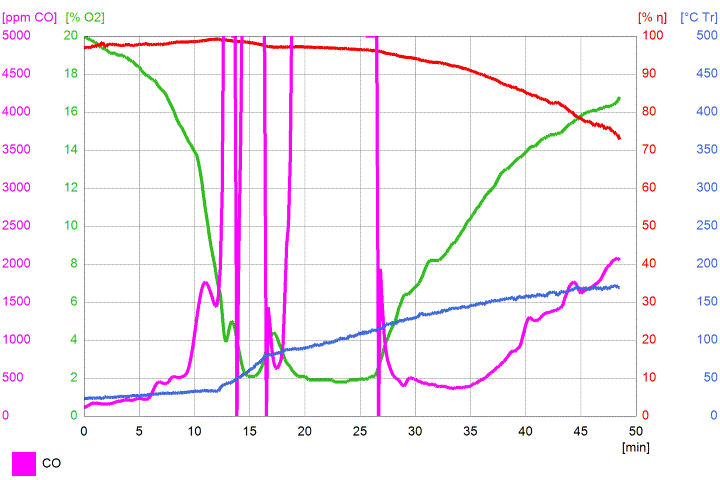 As can be seen, O² level took a steep dive to 1.8 % and the CO went through the roof during about 26 minutes. Suffice to say, it smoked, the afterburner door got pitch black very quick and the whole of the burn looked ehrmm, ugly. Today, I made provisions to adequately shrink the space above and around the tube down to just a tad over 100% of system size. I checked everything and loaded the thing again as the day before. Now it behaved quite differently, the O² went down to a level that most heaters would kick into smoking like mad. It's behaviour showed the 180º turn above the afterburner should be quite accurate. This burn appeared to be short and it was. Hard wood fuel is the next step to test this is viable as well. Lowest level of O² happened to be 3.1% this time, very low when one takes into account a high-specced natural gas central heating boiler wouldn't go lower than 4% O².  Averages of this run: O² 11.7%, eff. 91.7%, CO 582 ppm, stack temp 101ºC. For a certification test CO level is normalized to 13% O² in order to compare results. In this case, that would be 523 ppm, excellent result, I want to see more of those, please. |
|
|
|
Post by Solomon on Feb 22, 2021 15:56:43 GMT -8
For your efficiency line, that's combustion efficiency, right? So if CO was zero, efficiency would be approaching 100%, as in, all burnable fuel is burned? Am I understanding this correctly?
|
|
|
|
Post by martyn on Feb 22, 2021 23:18:48 GMT -8
So is the space above the horizontal riser stub is the same csa as the stub!
If so perhaps two stacked stubs, one top of each other would work?
That would be like a broken riser design?
|
|